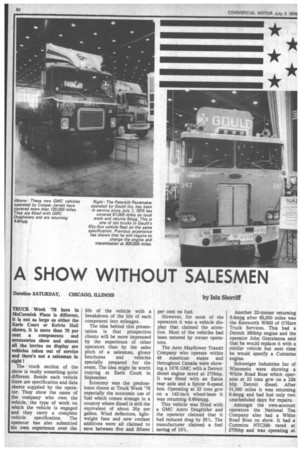A SHOW WITHOUT SALESMEN
Page 66

Page 67

If you've noticed an error in this article please click here to report it so we can fix it.
Dateline SATURDAY, CHICAGO, ILLINOIS by bin Sherriff TRUCK Week '76 here in McCormick Place is different, It is not as large as either the Earls Court or Kelvin Hall shows, it is more than 70 per cent a components and accessories show and almost all the lorries on display are vehicles taken out of service and there's not a salesman in sight !
The truck section of the show is really something quite different. Beside each vehicle there are specification and data sheets supplied by the operator. They show the name of the company who own the vehicle, the type of work on which the vehicle is engaged and they carry a complete vehicle specification. The operator has also submitted his own experience over the life of the vehicle with a breakdown of the life of each component into mileages.
The idea behind this presentation is that prospective clients will be more impressed by the experience of other operators than by the sales pitch of a salesman, glossy brochures and vehicles specially prepared for the event. The idea might be worth copying at Earls Court in September.
Economy was the predominant theme at Truck Week '76 especially the economic use of fuel which comes strange in a country where diesel is still the equivalent of about 30p per gallon. Wind deflectors, lightweight fans and new coolant additives were all claimed to save between five and fifteen per cent on fuel.
However, for most of the operators it was a vehicle display that claimed the attention. Most of the vehicles had been entered by owner operators.
The Aero Mayflower Transit Company who operate within 48 American states and throughout Canada were showing a 1976 GMC with a Detroit diesel engine rated at 270bhp. It was fitted with an Eaton rear axle and a Spicer 6-speed box. Operating at 32 tons gcw on a 142-inch wheel-base it was returning 6.664mpg.
This vehicle was fitted with a GMC Astro Dragfoiler and the operator claimed that it had reduced drag by 35°.:,. The manufacturer claimed a fuel saving of 10%. Another 32-tonner returning 6.4mpg after 65,000 miles was the Kenworth W900 of O'Hare Truck Services. This had a Detroit 360bhp engine and the operator John Gratzianna said that he would replace it with a similar vehicle but next time he would specify a Cummins engine.
Schweiger Industries Inc of Wisconsin were showing a White Road Boss which operates at 22 tons gcw on a 238 bhp Detroit diesel. After 91,000 miles it was returning 6.4mpg and had lost only two unscheduled days for repairs.
Amongst the own-account operators the National Tea Company also had a White Road Boss on show. It had a Cummins NTC290 rated at 270bhp and was operating at 0 tons gcw. It was returning .8mpg after 36,547 miles. The 3 ton White Freightliner outt of Olinkraft Inc was returnrg 5.75mpg and using one allon of oil for each thousand ales.
In five years the Interational bulk tanker displayed y Indianhead Truckline °perking at 38 ton gcw had pvered 610,000 miles with a iel consumption of 5.71. The Igine had been overhauled at 36,000 miles and the transiission at 230,000 miles. The ijectors were replaced at ?1,000 miles. The mainten ance superintendent Bob Sergeant said that he would change whatever components he could to improve efficiency.
This vehicle has been built down in weight and the components, the cab, the frame, bumper, drive-wheels, diffhousing, fly-wheel housing and fuel tank were all made of aluminium.
Advance United Expressways with a Mack F700 were delighted with a 5,5mpg after 110,000 miles. This return should be seen against the fact that the mileage had been covered in less than six months. The vehicle had never been out of service but attention had been paid to oil and filters. The oil was changed every 16,000 miles, chassis points were lubricated at 4,000, fuel filters were changed at 8,000 and oil filters at 16,000.
The Ford LNT9000 operated by the Bridge Transportation Company since July, 1973, had clocked 325,483 miles and was returning 4.5 mpg. It operated at 36-tonne gcw. Oil changes were carried out at 4,000 mile intervals And the only major replacement had been an injector at 141,380 miles. The heaviest mileage was recorded on an International operating at 35-tonnes gcw and owned by Crouch Freight Systems. In four years it had accumulated mileage of 757,258 miles and the original engine had been replaced at 300,000 miles. It was still operating on the original transmission.
This was the sort of information visitors could pick-up. Not all of it was complimentary, nevertheless it appeared to be having the desired effect of gaining the confidence of the customers to Truck Week.




































































































































